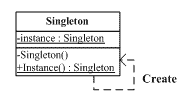單例模式三種寫法:
第一種最簡單,但沒有考慮線程安全,在多線程時可能會出問題
public class Singleton
{
private static Singleton _instance = null;
private Singleton(){}
public static Singleton CreateInstance()
{
if(_instance == null)
{
_instance = new Singleton();
}
return _instance;
}
}
第二種考慮了線程安全,是正規寫法,經典的一叉
public class Singleton
{
private volatile static Singleton _instance = null;
private static readonly object lockHelper = new object();
private Singleton(){}
public static Singleton CreateInstance()
{
if(_instance == null)
{
lock(lockHelper)
{
if(_instance == null)
_instance = new Singleton();
}
}
return _instance;
}
}
第三種可能是C#這樣的高級語言特有
public class Singleton
{
private Singleton(){}
public static readonly Singleton instance = new Singleton();
}
單例模式的特點:
單例模式應用:

Singleton模式包含的角色只有一個,就是Singleton。Singleton擁有一個私有構造函數,確保用戶無法通過new直接實例它。除此之外,該模式中包含一個靜態私有成員變量instance與靜態公有方法Instance()。Instance方法負責檢驗並實例化自己,然後存儲在靜態成員變量中,以確保只有一個實例被創建。(關於線程問題以及C#所特有的Singleton將在後面詳細論述)
該程序演示了Singleton的結構,本身不具有任何實際價值。
// Singleton pattern -- Structural example
using System;
// "Singleton"
class Singleton
{
// Fields
private static Singleton instance;
// Constructor
protected Singleton() {}
// Methods
public static Singleton Instance()
{
// Uses "Lazy initialization"
if( instance == null )
instance = new Singleton();
return instance;
}
}
/// <summary>
/// Client test
/// </summary>
public class Client
{
public static void Main()
{
// Constructor is protected -- cannot use new
Singleton s1 = Singleton.Instance();
Singleton s2 = Singleton.Instance();
if( s1 == s2 )
Console.WriteLine( "The same instance" );
}
}
使用Singleton模式有一個必要條件:在一個系統要求一個類只有一個實例時才應當使用單例模式。反過來,如果一個類可以有幾個實例共存,就不要使用單例模式。
注意:
不要使用單例模式存取全局變量。這違背了單例模式的用意,最好放到對應類的靜態成員中。
不要將數據庫連接做成單例,因為一個系統可能會與數據庫有多個連接,並且在有連接池的情況下,應當盡可能及時釋放連接。Singleton模式由於使用靜態成員存儲類實例,所以可能會造成資源無法及時釋放,帶來問題。
下面這段Singleton代碼演示了負載均衡對象。在負載均衡模型中,有多台服務器可提供服務,任務分配器隨機挑選一台服務器提供服務,以確保任務均衡(實際情況比這個復雜的多)。這裡,任務分配實例只能有一個,負責挑選服務器並分配任務。
// Singleton pattern -- Real World example
using System;
using System.Collections;
using System.Threading;
// "Singleton"
class LoadBalancer
{
// Fields
private static LoadBalancer balancer;
private ArrayList servers = new ArrayList();
private Random random = new Random();
// Constructors (protected)
protected LoadBalancer()
{
// List of available servers
servers.Add( "ServerI" );
servers.Add( "ServerII" );
servers.Add( "ServerIII" );
servers.Add( "ServerIV" );
servers.Add( "ServerV" );
}
// Methods
public static LoadBalancer GetLoadBalancer()
{
// Support multithreaded applications through
// "Double checked locking" pattern which avoids
// locking every time the method is invoked
if( balancer == null )
{
// Only one thread can obtain a mutex
Mutex mutex = new Mutex();
mutex.WaitOne();
if( balancer == null )
balancer = new LoadBalancer();
mutex.Close();
}
return balancer;
}
// Properties
public string Server
{
get
{
// Simple, but effective random load balancer
int r = random.Next( servers.Count );
return servers[ r ].ToString();
}
}
}
/// <summary>
/// SingletonApp test
/// </summary>
///
public class SingletonApp
{
public static void Main( string[] args )
{
LoadBalancer b1 = LoadBalancer.GetLoadBalancer();
LoadBalancer b2 = LoadBalancer.GetLoadBalancer();
LoadBalancer b3 = LoadBalancer.GetLoadBalancer();
LoadBalancer b4 = LoadBalancer.GetLoadBalancer();
// Same instance?
if( (b1 == b2) && (b2 == b3) && (b3 == b4) )
Console.WriteLine( "Same instance" );
// Do the load balancing
Console.WriteLine( b1.Server );
Console.WriteLine( b2.Server );
Console.WriteLine( b3.Server );
Console.WriteLine( b4.Server );
}
}
C#的獨特語言特性決定了C#擁有實現Singleton模式的獨特方法。這裡不再贅述原因,給出幾個結果:
方法一:
下面是利用.NET Framework平台優勢實現Singleton模式的代碼:
 sealed class Singleton
sealed class Singleton {
{ private Singleton();
private Singleton(); public static readonly Singleton Instance=new Singleton();
public static readonly Singleton Instance=new Singleton(); }
}
這使得代碼減少了許多,同時也解決了線程問題帶來的性能上損失。那麼它又是怎樣工作的呢?
注意到,Singleton類被聲明為sealed,以此保證它自己不會被繼承,其次沒有了Instance的方法,將原來_instance成員變量變成public readonly,並在聲明時被初始化。通過這些改變,我們確實得到了Singleton的模式,原因是在JIT的處理過程中,如果類中的static屬性被任何方法使用時,.NET Framework將對這個屬性進行初始化,於是在初始化Instance屬性的同時Singleton類實例得以創建和裝載。而私有的構造函數和readonly(只讀)保證了Singleton不會被再次實例化,這正是Singleton設計模式的意圖。
不過這也帶來了一些問題,比如無法繼承,實例在程序一運行就被初始化,無法實現延遲初始化等。
詳細情況可以參考微軟MSDN文章
方法二:
既然方法一存在問題,我們還有其它辦法。
public sealed class Singleton
{
Singleton()
{
}
public static Singleton GetInstance()
{
return Nested.instance;
}
class Nested
{
// Explicit static constructor to tell C# compiler
// not to mark type as beforefieldinit
static Nested()
{
}
internal static readonly Singleton instance = new Singleton();
}
}
這實現了延遲初始化,並具有很多優勢,當然也存在一些缺點。文章包含五種Singleton實現,就模式、線程、效率、延遲初始化等很多方面進行了詳細論述。